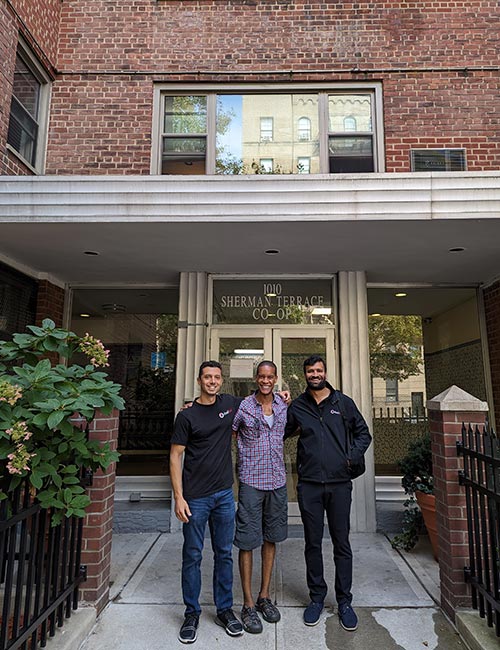Sherman Terrace Cooperative
Bronx County

A Bronx Housing Coop Takes a Phased-In Approach to Energy Efficiency
Sherman Terrace Cooperative, located in the Bronx, is a 67-unit building constructed in 1957. Its proactive board and shareholders are committed to tackling rising energy costs and finding ways to reduce the co-op's greenhouse gas (GHG) emissions while maintaining resident comfort.
The Cooperative’s goals were inspired in part by the adjacent Bronx neighborhood of Melrose, a community dedicated to sustainability, supporting the public’s trust and civic responsibility, as well as the establishment of a physical and economic base for renewal and growth.
By embracing energy efficiency and modernizing its energy infrastructure, the board and shareholders committed to a phased approach.
The 80,000-square-foot residential coop benefits from real-time energy management and is now compliant with NYC’s local laws.
Energy Savings Results:
26,095 therms
Approximately $53,235 in annual cost reduction
Step 1:
Fuel Oil #4 to Fuel Oil #2 to Natural Gas
Initially, the building had an oil boiler that generated the building’s steam and domestic hot water. The boiler, which ran on #4 fuel oil, was updated in 2015 to #2 oil, in accordance with NYC Department of Environmental Protection’s guidance for phasing out the most polluting heating oils.
Then, in 2018, the Sherman Terrace Cooperative board approached Dual Fuel to explore the transition from #2 oil to natural gas for the boiler.
Dual Fuel, located in Mt. Vernon, is a mechanical contractor specializing in remote monitoring and automated control of heating systems. Dual Fuel has been a NYSERDA qualified RTEM Vendor since 2016. In 2020, the transition to natural gas began. The co-op first re-financed the mortgage and took advantage of a lower interest rate. The savings realized were intentionally invested in its energy conscious approach.
Step 2:
Install Digital Boiler Controls with Real Time Energy Management (RTEM) Capabilities
Dual Fuel’s objective was to optimize the heating and the domestic hot water systems. They implemented a real-time energy management (RTEM) system that:
- Reduced total boiler runtime
- Ensured ideal comfort for building residents
- Based boiler operations on the indoor temperatures of a sample of the residential units, instead of outdoor air temperature.
Additionally, Dual Fuel provided the board with findings on the data collected after the RTEM system was installed and commissioned. The system provides real time alarming in the form of emails and text messages when faults are detected. Some examples of faults are flame failure (which indicates that the burner cannot properly produce a flame) and high makeup water (which indicate leaks in the piping).
Dual Fuel reviews site data on a rolling monthly basis to determine any general maintenance needs. Any maintenance recommendations, energy conservation measures, and capital improvements that are needed are included in quarterly reports, presented by Dual Fuel.


Project participants at the coop, l-r: Jonathan Benezry, Product Engineer at Dual Fuel; Derek Jones, Presi-dent of Sherman Terrace Cooperative; Rush Shah, Director of Controls at Dual Fuel
Two Distinct Challenges
Multidisciplinary Trade Skills: A major challenge of this infrastructure project was the need for multidisciplinary trade skills, including plumbing, power and electricity, boilers, controls and IP networking to enable data sharing. These types of skills typically entail working with several vendors.
However, Dual Fuel acted as a one stop shop and provided holistic mechanical contracting, controls, and monitoring and data integration services. This removed the burden of coordinating multiple vendors from the board’s list of responsibilities.
Minimal Disturbance to Residents: Another challenge was minimizing disturbance to residents. The choice of wireless temperature sensors made apartment entries quick and easy.
Results
The project’s results were impressive, with reduced energy spend, cost, and greenhouse gas emissions, enhanced resident comfort, increased awareness of carbon footprint on a granular (apartment) level, and improved indoor air quality (IAQ).
The upgrades resulted in annual energy savings of 26,095 therms, translating to approximately $53,235 in annual cost reduction.
The co-op is now compliant with NYC’s Local Laws and boasts an ENERGY STAR® rating of 92.
Phase 3: Looking Ahead
The co-op is working closely with their energy consultant, EN-POWER Group ![]() , to create a long-term capital improvement plan focused on energy savings and phased capital improvements.
, to create a long-term capital improvement plan focused on energy savings and phased capital improvements.
As it plans for Phase 3, the co-op is considering upgrades like heat pump technology and water conservation measures such as toilet replacements and green roof installation.
Sherman Terrace Cooperative exemplifies an effective transition toward sustainable and energy-efficient practices. The transition benefits both the environment and its shareholders. The co-op has joined the forefront of urban energy conservation and on-site energy generation.
Transform the way you manage and consume energy.
Visit nyserda.ny.gov/RTEM for more information.
